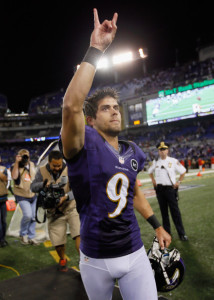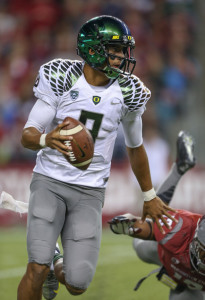I am getting some well-deserved crap from people about just how bad my predictions have been so far. The Arizona Cardinals have already somehow outperformed the number of wins I gave them. The Jacksonville Jaguars, my pick to win the AFC South at 8-8, at one point in the game against the Colts had been outscored 112-13 over a stretch of about nine quarters. And my pick to win the NFC North at 14-2 could be 0-3 if Marty Mornhinweg let his head coach call the timeouts.
But I did win my first Stone-Cold Mega-Lock of the Week with my very comfortable tease of the Bengals and Falcons. So things are looking up and I’m taking that as license to check out some historical betting data for anything that might seem appealing after three weeks.
Last year’s Carolina Panthers are the inspiration for the analysis here. After three weeks, they were a 1-2 team with a big positive point differential. The Panthers last year lost 12-7 to Seattle and 24-23 to Buffalo before annihilating the Giants 38-0. Despite VOA liking the Panthers even after just three games, the betting market came around later in at least one way. The Panthers were at 3/1 to make the playoffs last year after three weeks, even though Football Outsiders had their playoff odds at over 50% at that time.
Is it possible that teams like the 2013 Panthers have historically been undervalued? It seems likely that Carolina was a little undervalued last year after three weeks. By looking at point spread data, we can see if teams that have likely been better than their records have been good bets in the early part of the season. Specifically, I’m going to look at whether betting on early-season underachievers (teams with deceptively poor records) or against overachievers has been profitable now and in the past.
Data and Methods
Feel free to skip this part, but here’s the background for those interested. I have put together Pro Football Reference’s point spread data for all games from 1979 to 2012. This sample is good enough for the tests of long-term and recent betting strategies that I want to do.
I’m going to look at betting outcomes in games 4-8 for teams that are either losing teams (winning percentage below 0.5) with strong Pythagorean records or winning teams with weak Pythagorean records. I will keep things simple and define Pythagorean wins here as:
Pythagorean Wins = (Previous Points Scored ^2.53)/(Previous Points Scored^2.53 + Previous Points Allowed^2.53)
In a continuing effort to avoid unnecessary complications, I’m just going to split the data up over time, looking separately at results before and after 2000.
Betting On and Against Pythagorean Outliers
Below is how you would have done over time if you bet on or against two kinds of teams:
- Overachievers: Teams with winning records with bad point differentials for their records
- Underachievers: Teams with losing records with good point differentials for their records
An overachiever is more specifically a team with a winning record that has a Pythagorean winning percentage at least 25 percentage points worse than their actual winning percentage. An underachiever has a Pythagorean winning percentage at least 25 percentage points better than actual.
| Years | Overachieving Teams | Underachieving Teams |
| 1979-1999 | 174-142-11 (55.1%) | 141-146-5 (50.9%) |
| 2000-2012 | 109-99-4 (52.4%) | 108-100-8 (52.0%) |
The results show that, before 2000, you would have won most of the time betting on overachieving teams, teams that were not as good as their records would suggest. I was surprised by that and it even made me wonder if I made a coding mistake. I certainly expected that any tendency away from an even split would have been in favor of betting against teams with good records and relatively poor point differentials. Note that the even split occurred in the past for the underachievers, the teams with good point differentials and poor records.
More recently, the data come pretty close to an even split for betting both on the overachievers and the underachievers. Betting on the overachievers and the underachievers has been successful about 52% of the time since 1999.
So the overall message is that there is little value now or in the past in identifying Pythagorean outliers and either riding the teams with deceptively poor records or fading the teams with misleadingly good ones. In fact, the only pattern from the past suggested it was a good idea to ride the teams with misleadingly good records. I tried to check this out a bit to just see if it was just betting on teams with good records that was profitable, but betting on all teams with winning percentages over .750 has gone almost exactly dead even over time. It would be great to hear any thoughts you might have in the comments for this pattern. I feel like I’m missing something.
Overall, the message here is the one that we get most of the time if we try to find patterns that might lead to a consistently profitable and simple betting strategy. It just ain’t there. That doesn’t make this a bad post, though: as Chase once noted, an answer of “not useful” is often just as meaningful as any other answers.
The Stone-Cold (I Think There May Be a 60% Chance This Bet Will Win) Mega-Lock of the Week
So I am now 33% on my Stone-Cold Mega Locks of the Week. If I get the next two, I will be at 60%. If I get the next two after that, I’ll be at 71%. I kind of think I should be able to claim extra points already, Chris Berman-style, for my tease last week, since the Falcons and Bengals won by a combined 89-21 score that wasn’t that close. But I will instead put my faith in the always reliable larger sample size that will bear out these predictions living up to their title.
Two-team teaser: Pittsburgh down to -1.5 and Indianapolis down to -1.5
This week, I like another two-team teaser of two home teams, this time down to 1.5 points. I particularly like the Steelers down to 1.5 points. I do not understand how they could be the same offense for quarters 3-8 of this season as they were for the other high-efficiency ones. Still, I like the Steelers (#10 in DVOA) at home against the Buccaneers (#32).
I’m a little less sure about the other side of the tease, where I have Indianapolis (#21) over Tennessee (#25). In fact, I mainly just wanted to get the Pittsburgh end of the tease. I may be getting that queasy-knees feeling come Sunday. It’s hard to feel that way about Andrew Luck, but I didn’t imagine I’d ever be going into the water tethered to a Ryan Grigson-led team.
Season record: 1-2







